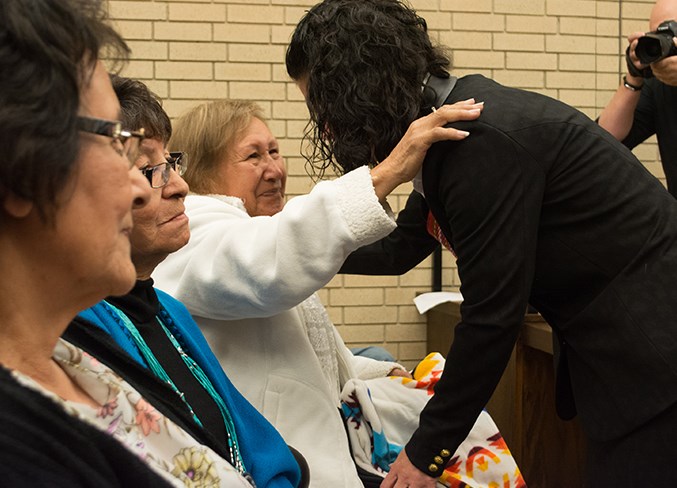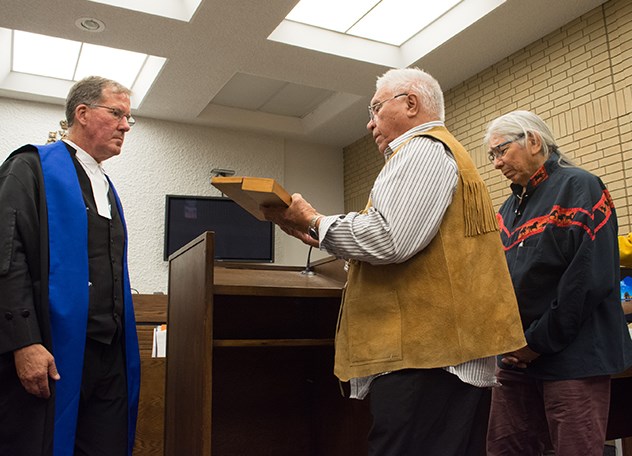Five judges. Three Crown prosecutors. A gallery full of expectant faces, full of tears and smiles.
June 28 was not an average day in Athabasca Provincial Court.
The local courtroom became the venue for a small step toward conciliation as the bench accepted an eagle feather to be kept on the dais, where it will be used for swearing oaths.
Members of the Alberta justice service came together with about 60 representatives of Treaties 6, 7 and 8, the Métis Nation of Alberta and the Athabasca community for the ceremony, which makes Athabasca the second jurisdiction in the province to have an eagle feather inducted into the courtroom.
Speaking at the event, Treaty 8 Elder Mike Beaver said the eagle is very sacred, and his ancestors used the eagle feather as a powerful instrument.
“We don’t have a bible in our spirituality,” he said. “(We) will now have the option to hold a feather as (we) are telling the truth and nothing but the truth.”
Judge Clifton Purvis began the proceedings in the courtroom where he so often hands out sentences, noting the importance that everyone have confidence in the justice system.
“For people to have confidence, they have to know they will be heard, and they deserve to have their culture and faith recognized,” he said.
Elder Richard Lightning of Treaty 6 commended the ceremony as “a big step for the communities.”
“I had enough of the Bible,” he said, while speaking about his time in the residential school.
Journey
The presence of an eagle feather in Athabasca Provincial Court is the culmination of a series of events that began after a visit to Calling Lake and Bigstone Cree Nation.
Crown prosecutor Sandra Christensen-Moore said she went to visit the area in October 2018 when she was officially assigned to the Athabasca area. During her visit, as the restorative justice program expanded into Calling Lake, she was given a cedar box.
“It was there the potential for a feather coming into our Athabasca court surfaced,” Christensen-Moore said.
With the idea “planted,” Christensen-Moore began working with community members and other justice representatives how to bring an eagle feather to the local courtroom.
She said that from there, community members donated time and effort until the regional program manager for police-based victim services Melody Littell offered an eagle feather. Christensen-Moore said the feather had been gifted to Littell’s father, and she told Christensen-Moore “her feather had found its calling and its home.”
Christensen-Moore — who is also a member of the Métis Nation of Alberta — said that along with speaking on behalf of Alberta Justice, she had a personal message of gratitude.
“I’m so grateful to the communities in and around Athabasca and Calling Lake,” she said. “You have been so welcoming. And what a rare privilege to serve two Treaty lands.”
She said she feels close to the Calling Lake community.
“As a community, you are small, but you are mighty and you are dreamers. And that makes that community magic,” she said.
 Christensen-Moore (right) hands a blanket to Vivian House from Calling Lake.
Christensen-Moore (right) hands a blanket to Vivian House from Calling Lake.
Conciliation
Christensen-Moore called the event a part of the process of conciliation.
“Past relations (between the Crown and Indigenous Peoples) have been strained, unjust, ignorant, and in many cases, cruel,” Christensen-Moore said.
“Reconciliation implies we are returning to a time when we had good relations and we understood each other,” she said. “I don’t think we’re in a position to say it’s reconciliation. We are starting to improve and get it right for the very first time.”
While some speakers also joked about what had brought them into the courtroom in the past, others spoke about how their previous experiences affected them.
Gloria Anderson touched on the trauma the court had brought to her. A grandmother from Calling Lake, she said as she drove into town from Calling Lake that day, she was faced with the memories she had from the Athabasca courtroom.
“I witnessed my father — he was charged with driving with no driver’s license, arrested, shackled and taken away,” Anderson said.
“It is important to recognize the feather, but my hope is that it will go further than that,” Anderson said. “That there will be action in the justice system when it comes to dealing with our people.”
Justice
Lightning said many people were traumatized in the system and did not have a chance to learn their culture.
“This courthouse has opened its doors to many young people,” Lightning said. “Unfortunately, they’ll keep coming through these doors. The child care and foster system, those things are broken. They’re not working for us. These are the people we have to keep in mind. They have (the eagle feather) here to guide them on their journey in life.”
“We operate from a trauma-informed perspective,” said Helen Flamand, who works with the Bigstone Cree Nation Restorative Justice Program. “We believe that this and other processes are a good start. The feather is a symbol of trust, bravery and honesty. It’s all about healing. This is a monumental moment.”
The assistant deputy minister for the Alberta Crown Prosecution Eric Tolppanen attended the ceremony as a Crown representative. Speaking after the event, he said the induction ceremony is an important step in making the justice system more relevant and meaningful to the Indigenous community served by the court.
“It’s also an important step in the process of conciliation as between Indigenous communities and the court,” he said. “The induction ceremony was the culmination of a community-based collaboration.”
Anderson said before justice can happen, people have to reconnect, and then the reconciliation starts.
“We have to connect first,” Anderson said. “And this is the beginning, with the feather. We’re connecting again.”



